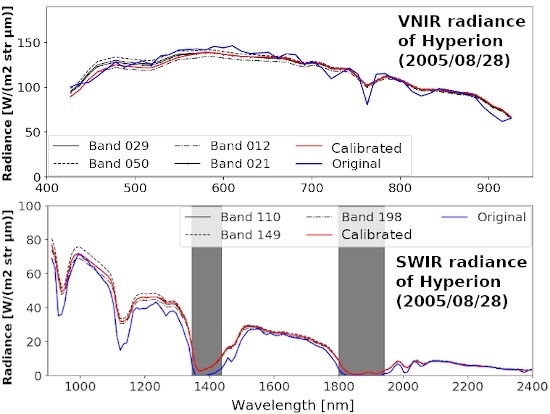Combination of Cross- and Inter-Band Radiometric Calibrations for a Hyperspectral Sensor Using Model-Based Spectral Band Adjustment
Abstract
1. Introduction
2. Materials and Methods
2.1. Site Information
2.2. Satellite Data for Cross-Calibration
2.3. Cross-Calibration between Analogous Bands of Hyperion and MODIS
2.4. Inter-Band Calibration of Hyperion
3. Results
3.1. Cross-Calibration between the Analogous Bands of Hyperion and MODIS
3.2. Inter-Band Calibration of Hyperion
4. Discussion
5. Conclusions
Author Contributions
Funding
Acknowledgments
Conflicts of Interest
Appendix A
- (1)
- radiometric calibration uncertainty of MODIS,
- (2)
- variability in atmospheric conditions,
- (3)
- soil line influence,
- (4)
- geolocation error of Hyperion, and
- (5)
- solar irradiance model
| AOT at 550 nm | Junge Parameter | Water Vapor (g/cm2) | Ozone (Dobson Unit) | |
|---|---|---|---|---|
| Mean | 0.074 | 3.25 | 0.81 | 296.3 |
| Standard deviation | 0.053 | 0.49 | 0.40 | 17.1 |
- (1)
- the Hyperion reference bands,
- (2)
- variability in atmospheric conditions,
- (3)
- soil line influence, and
- (4)
- solar irradiance model
References
- Transon, J.; d’Andrimont, R.; Maugnard, A.; Defourny, P. Survey of hyperspectral earth observation applications from space in the Sentinel-2 context. Remote Sens. 2018, 10, 157. [Google Scholar] [CrossRef]
- Campbell, P.K.E.; Middleton, E.M.; Thome, K.J.; Kokaly, R.F.; Huemmrich, K.F.; Lagomasino, D.; Novick, K.A.; Brunsell, N.A. EO-1 Hyperion reflectance time series at calibration and validation sites: Stability and sensitivity to seasonal dynamics. IEEE J-STARS 2013, 6, 276–290. [Google Scholar] [CrossRef]
- Marshall, M.; Thenkabail, P. Advantage of hyperspectral EO-1 Hyperion over multispectral IKONOS, GeoEye-1, WorldView-2, Landsat ETM+, and MODIS vegetation indices in crop biomass estimation. ISPRS J. Photogramm. 2015, 108, 205–218. [Google Scholar] [CrossRef]
- Van der Meer, F.D.; van der Werff, H.M.A.; van Ruitenbeek, F.J.A.; Hecker, C.A.; Bakker, W.H.; Noomen, M.F.; van der Meijde, M.; Carranza, E.J.M.; de Smeth, J.B.; Woldai, T. Multi- and hyperspectral geologic remote sensing: A review. Int. J. Appl. Earth Obs. 2012, 14, 112–128. [Google Scholar] [CrossRef]
- Thome, K.J.; Biggar, S.F.; Wisniewski, W. Cross comparison of EO-1 Sensors and other earth resources sensors to Landsat-7 ETM+ using Railroad Valley Playa. IEEE Trans. Geosci. Remote Sens. 2003, 41, 1180–1188. [Google Scholar] [CrossRef]
- Obata, K.; Tsuchida, S.; Yamamoto, H.; Thome, K. Cross-calibration between ASTER and MODIS visible to near-infrared bands for improvement of ASTER radiometric calibration. Sensors 2017, 17, 1793. [Google Scholar] [CrossRef]
- Obata, K. Sensitivity analysis method for spectral band adjustment between hyperspectral sensors: A case study using the CLARREO Pathfinder and HISUI. Remote Sens. 2019, 11, 1367. [Google Scholar] [CrossRef]
- Heidinger, A.K.; Cao, C.; Sullivan, J.T. Using Moderate Resolution Imaging Spectrometer (MODIS) to calibrate advanced very high resolution radiometer reflectance channels. J. Geophys. Res. Atmos. 2002, 107. [Google Scholar] [CrossRef]
- Wu, A.; Xiong, X.; Cao, C. Terra and Aqua MODIS inter-comparison of three reflective solar bands using AVHRR onboard the NOAA-KLM satellites. Int. J. Remote Sens. 2008, 29, 1997–2010. [Google Scholar] [CrossRef]
- Barrientos, C.; Mattar, C.; Nakos, T.; Perez, W. Radiometric cross-calibration of the Chilean satellite FASat-C using RapidEye and EO-1 Hyperion data and a simultaneous nadir overpass approach. Remote Sens. 2016, 8, 612. [Google Scholar] [CrossRef]
- McCorkel, J.; Thome, K.; Lockwood, R.B. Absolute radiometric calibration of narrow-swath imaging sensors with reference to non-coincident wide-swath sensors. IEEE Trans. Geosci. Remote Sens. 2013, 51, 1309–1318. [Google Scholar] [CrossRef]
- Mishra, N.; Haque, M.O.; Leigh, L.; Aaron, D.; Helder, D.; Markham, B. Radiometric cross calibration of Landsat 8 Operational Land Imager (OLI) and Landsat 7 Enhanced Thematic Mapper Plus (ETM+). Remote Sens. 2014, 6, 12619–12638. [Google Scholar] [CrossRef]
- Yu, F.; Wu, X. Radiometric inter-calibration between Himawari-8 AHI and S-NPP VIIRS for the solar reflective bands. Remote Sens. 2016, 8, 165. [Google Scholar] [CrossRef]
- Teillet, P.M.; Fedosejevs, G.; Thome, K.J.; Barker, J.L. Impacts of spectral band difference effects on radiometric cross-calibration between satellite sensors in the solar-reflective spectral domain. Remote Sens. Environ. 2007, 110, 393–409. [Google Scholar] [CrossRef]
- Chander, G.; Mishra, N.; Helder, D.L.; Aaron, D.B.; Angal, A.; Choi, T.; Xiong, X.; Doelling, D.R. Applications of spectral band adjustment factors (SBAF) for cross-calibration. IEEE Trans. Geosci. Remote Sens. 2013, 51, 1267–1281. [Google Scholar] [CrossRef]
- Yuan, K.; Thome, K.; McCorkel, J. Radiometric cross-calibration of Terra ASTER and MODIS. In Proceedings of the SPIE Optical Engineering + Applications, San Diego, CA, USA, 9–13 August 2015; Volume 9607, p. 960724. [Google Scholar]
- Farhad, M.M.; Kaewmanee, M.; Leigh, L.; Helder, D. Radiometric cross calibration and validation using 4 angle BRDF model between Landsat 8 and Sentinel 2A. Remote Sens. 2020, 12, 806. [Google Scholar] [CrossRef]
- Baret, F.; Jacquemoud, S.; Hanocq, J.F. About the soil line concept in remote sensing. Adv. Space Res. 1993, 13, 281–284. [Google Scholar] [CrossRef]
- Obata, K.; Tsuchida, S.; Iwao, K. Inter-band radiometric comparison and calibration of ASTER visible and near-infrared bands. Remote Sens. 2015, 7, 15140–15160. [Google Scholar] [CrossRef]
- Ungar, S.G.; Pearlman, J.S.; Mendenhall, J.A.; Reuter, D. Overview of the earth observing one (EO-1) mission. IEEE Trans. Geosci. Remote Sens. 2003, 41, 1149–1159. [Google Scholar] [CrossRef]
- Franks, S.; Neigh, C.S.R.; Campbell, P.K.; Sun, G.; Yao, T.; Zhang, Q.; Huemmrich, K.F.; Middleton, E.M.; Ungar, S.G.; Frye, S.W. EO-1 data quality and sensor stability with changing orbital precession at the end of a 16 year mission. Remote Sens. 2017, 9, 412. [Google Scholar] [CrossRef]
- McCorkel, J.; Thome, K.; Ong, L. Vicarious calibration of EO-1 hyperion. IEEE J-STARS 2013, 6, 400–407. [Google Scholar] [CrossRef]
- Czapla-Myers, J.; Ong, L.; Thome, K.; McCorkel, J. Validation of EO-1 hyperion and advanced land imager using the radiometric calibration test site at railroad valley, Nevada. IEEE J-STARS 2016, 9, 816–826. [Google Scholar] [CrossRef]
- Jing, X.; Leigh, L.; Helder, D.; Pinto, C.T.; Aaron, D. Lifetime absolute calibration of the EO-1 Hyperion sensor and its validation. IEEE Trans. Geosci. Remote Sens. 2019, 57, 9466–9475. [Google Scholar] [CrossRef]
- Xiong, X.; Sun, J.; Wu, A.; Chiang, K.-F.; Esposito, J.; Barnes, W. Terra and Aqua MODIS calibration algorithms and uncertainty analysis. In Proceedings of the SPIE Remote Sensing, Bruges, Belgium, 19–22 September 2005; Volume 5978, p. 59780V. [Google Scholar]
- Yokoya, N.; Mayumi, N.; Iwasaki, A. Cross-calibration for data fusion of EO-1/Hyperion and Terra/ASTER. IEEE J-STARS 2013, 6, 419–426. [Google Scholar] [CrossRef]
- Ravi Shankar, D. Remote Sensing of Soils: Earth Observation Systems; Springer: Berlin/Heidelberg, Germany, 2017; p. 70. [Google Scholar]
- Lacherade, S.; Fougnie, B.; Henry, P.; Gamet, P. Cross calibration over desert sites: Description, methodology, and operational implementation. IEEE Trans. Geosci. Remote Sens. 2013, 51, 1098–1113. [Google Scholar] [CrossRef]
- Scott, K.P.; Thome, K.J.; Brownlee, M.R. Evaluation of the Railroad Valley Playa for use in vicarious calibration. In Proceedings of the SPIE’s 1996 International Symposium on Optical Science, Engineering, and Instrumentation, Denver, CO, USA, 4–9 August 1996; Volume 2818, pp. 158–166. [Google Scholar]
- Bouvet, M.; Thome, K.; Berthelot, B.; Bialek, A.; Czapla-Myers, J.; Fox, N.P.; Goryl, P.; Henry, P.; Ma, L.; Marcq, S.; et al. RadCalNet: A radiometric calibration network for Earth observing imagers operating in the visible to shortwave infrared spectral range. Remote Sens. 2019, 11, 2401. [Google Scholar] [CrossRef]
- Giles, D.M.; Sinyuk, A.; Sorokin, M.G.; Schafer, J.S.; Smirnov, A.; Slutsker, I.; Eck, T.F.; Holben, B.N.; Lewis, J.R.; Campbell, J.R.; et al. Advancements in the Aerosol Robotic Network (AERONET) Version 3 database—Automated near-real-time quality control algorithm with improved cloud screening for Sun photometer aerosol optical depth (AOD) measurements. Atmos. Meas. Tech. 2019, 12, 169–209. [Google Scholar] [CrossRef]
- Tsuchida, S.; Yamamoto, H.; Kouyama, T.; Obata, K.; Sakuma, F.; Tachikawa, T.; Kamei, A.; Arai, K.; Czapla-Myers, J.S.; Biggar, S.F.; et al. Radiometric degradation curves for the ASTER VNIR processing using vicarious and Lunar calibrations. Remote Sens. 2020, 12, 427. [Google Scholar] [CrossRef]
- Members of the MODIS Characterization Support Team. MODIS Level 1B Product User’s Guide; National Aeronautics and Space Administration, Goddard Space Flight Center: Greenbelt, MD, USA, 2017.
- LAADS DAAC. Available online: https://ladsweb.modaps.eosdis.nasa.gov (accessed on 13 March 2020).
- MODIS Characterization Support Team (MCST). Available online: https://mcst.gsfc.nasa.gov/calibration/parameters (accessed on 13 March 2020).
- Earth Explorer. Available online: http://earthexplorer.usgs.gov (accessed on 13 March 2020).
- Thome, K.J.; Arai, K.; Tsuchida, S.; Biggar, S.F. Vicarious calibration of ASTER via the reflectance-based approach. IEEE Trans. Geosci. Remote Sens. 2008, 46, 3285–3295. [Google Scholar] [CrossRef]
- Biggar, S.F.; Slater, P.N.; Gellman, D.I. Uncertainties in the in-flight calibration of sensors with reference to measured ground sites in the 0.4–1.1 μm range. Remote Sens. Environ. 1994, 48, 245–252. [Google Scholar] [CrossRef]
- Nishihama, M.; Wolfe, R.; Solomon, D.; Patt, F.; Blanchette, J.; Fleig, A.; Masuoka, E. MODIS Level 1A Earth Location:Algorithm Theoretical Basis Document Version 3.0; National Aeronautics and Space Administration, Goddard Space Flight Center: Greenbelt, MD, USA, 1997.
- Gao, F.; Masek, J.; Schwaller, M.; Hall, F. On the blending of the Landsat and MODIS surface reflectance: Predicting daily Landsat surface reflectance. IEEE Trans. Geosci. Remote Sens. 2006, 44, 2207–2218. [Google Scholar]
- Roy, D.P.; Ju, J.; Lewis, P.; Schaaf, C.; Gao, F.; Hansen, M.; Lindquist, E. Multi-temporal MODIS-Landsat data fusion for relative radiometric normalization, gap filling, and prediction of Landsat data. Remote Sens. Environ. 2008, 112, 3112–3130. [Google Scholar] [CrossRef]
- Belgiu, M.; Stein, A. Spatiotemporal image fusion in remote sensing. Remote Sens. 2019, 11, 818. [Google Scholar] [CrossRef]
- Gao, F.; Anderson, M.C.; Zhang, X.; Yang, Z.; Alfieri, J.G.; Kustas, W.P.; Mueller, R.; Johnson, D.M.; Prueger, J.H. Toward mapping crop progress at field scales through fusion of Landsat and MODIS imagery. Remote Sens. Environ. 2017, 188, 9–25. [Google Scholar] [CrossRef]
- Mizuochi, H.; Hiyama, T.; Ohta, T.; Fujioka, Y.; Kambatuku, J.R.; Iijima, M.; Nasahara, K.N. Development and evaluation of lookup-table-based approach to data fusion for seasonal wetlands monitoring: An integrated use of AMSR series, MODIS, and Landsat. Remote Sens. Environ. 2017, 199, 370–388. [Google Scholar] [CrossRef]
- Chander, G.; Helder, D.L.; Aaron, D.; Mishra, N.; Shrestha, A.K. Assessment of spectral, misregistration, and spatial uncertainties inherent in the cross-calibration study. IEEE Trans. Geosci. Remote Sens. 2013, 51, 1282–1296. [Google Scholar] [CrossRef]
- Thuillier, G.; Herse, M.; Simon, P.C.; Labs, D.; Mandel, H.; Gillotay, D.; Foujols, T. The visible solar spectral irradiance from 350 to 850 nm as measured by the SOLSPEC spectrometer during the ATLAS I Mission. Sol. Phys. 1998, 177, 41–61. [Google Scholar] [CrossRef]
- Thuillier, G.; Herse, M.; Labs, D.; Foujols, T.; Peetermans, W.; Gillotay, D.; Simon, P.C.; Mandel, H. The solar spectral irradiance from 200 to 2400 nm as measured by the SOLSPEC spectrometer from the Atlas and Eureca Missions. Sol. Phys. 2003, 214, 1–22. [Google Scholar] [CrossRef]
- Bacour, C.; Briottet, X.; Breon, F.M.; Viallefont-Robinet, F.; Bouvet, M. Revisiting pseudo invariant calibration sites (PICS) over sand desert for vicarious calibration of optical imagers at 20 km and 100 km scales. Remote Sens. 2019, 11, 1166. [Google Scholar] [CrossRef]
- Alonso, K.; Bachmann, M.; Burch, K.; Carmona, E.; Cerra, D.; de los Reyes, R.; Dietrich, D.; Heiden, U.; Holderlin, A.; Ickes, J.; et al. Data products, quality and validation of the DLR Earth Sensing Imaging Spectrometer (DESIS). Sensors 2019, 19, 4471. [Google Scholar] [CrossRef] [PubMed]
- Matsunaga, T.; Iwasaki, A.; Tsuchida, S.; Iwao, K.; Nakamura, R.; Yamamoto, H.; Kato, S.; Obata, K.; Kashimura, O.; Tanii, J.; et al. HISUI status toward FY2019 launch. In Proceedings of the IGARSS 2018–2018 International Geoscience and Remote Sensing Symposium, Valencia, Spain, 22–27 July 2018; pp. 160–163. [Google Scholar]
- Petty, G.W. A First Course in Atmospheric Radiation, 2nd ed.; Sundog Publishing: Madison, WI, USA, 2006; pp. 175–183. [Google Scholar]
- Qu, J.J.; Gao, W.; Kafatos, M.; Murphy, R.E.; Salomonson, V.V. (Eds.) Earth Science Satellite Remote Sensing Vol. 1: Science and Instruments; Tsinghua University Press: Beijing, China; Springer: Berlin, Germany, 2006; pp. 50–73. [Google Scholar]
- Rodriguez, E.; Morris, C.S.; Belz, J.E.; Chapin, E.C.; Martin, J.M.; Daffer, W.; Hensley, S. An Assessment of the SRTM Topographic Products; Jet Propulsion Laboratory: Pasadena, CA, USA, 2005; p. 22. [Google Scholar]
- Neckel, H.; Labs, D. The solar radiation between 3300 and 12500Å. Sol. Phys. 1984, 90, 205–258. [Google Scholar] [CrossRef]
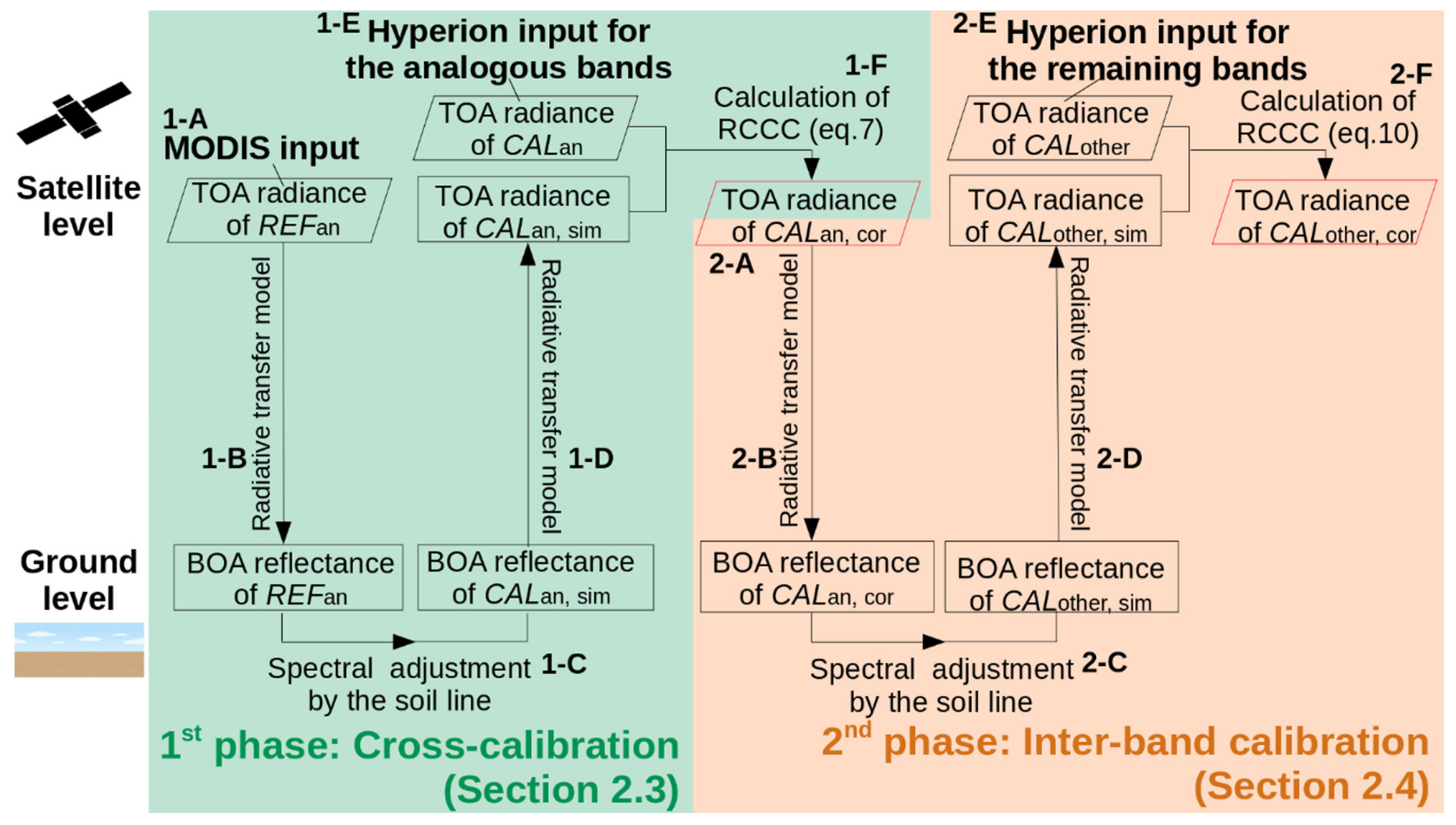
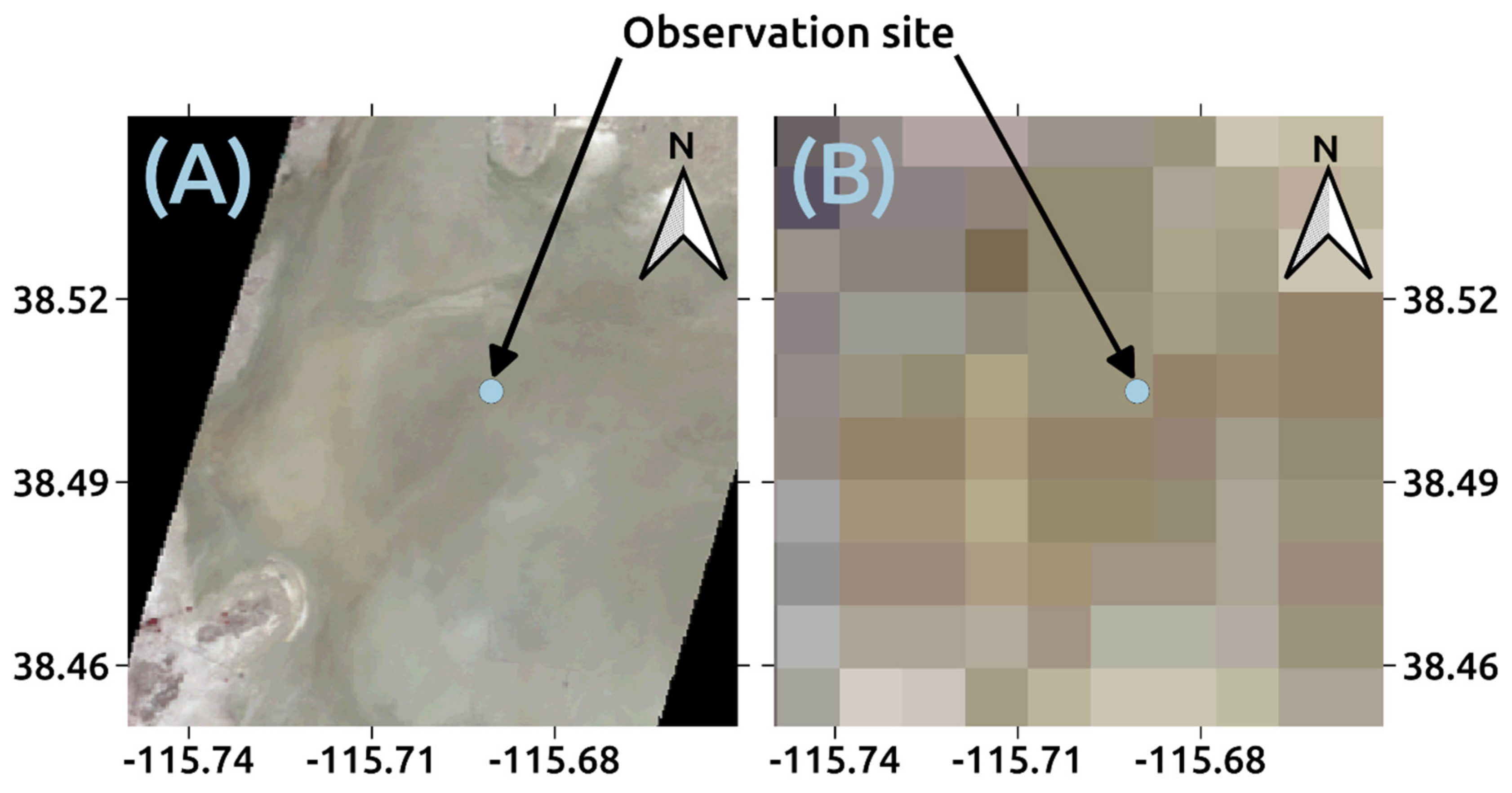
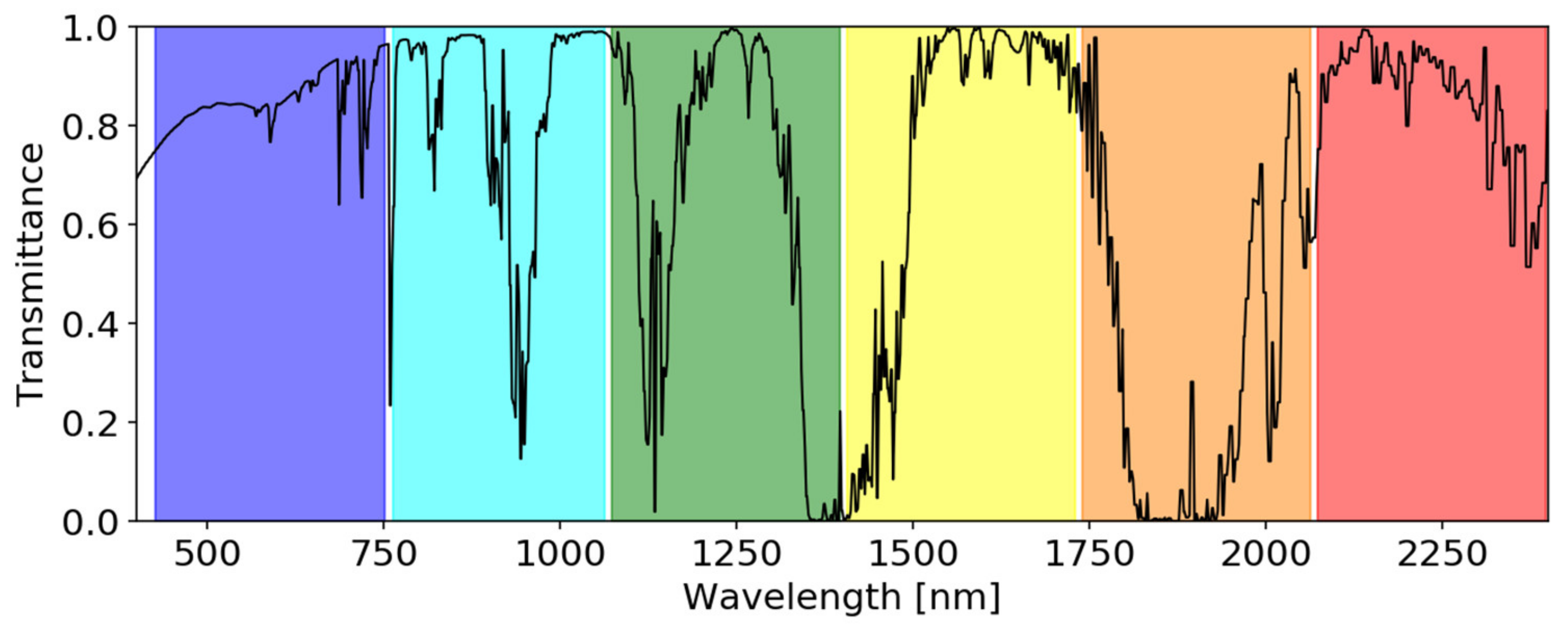

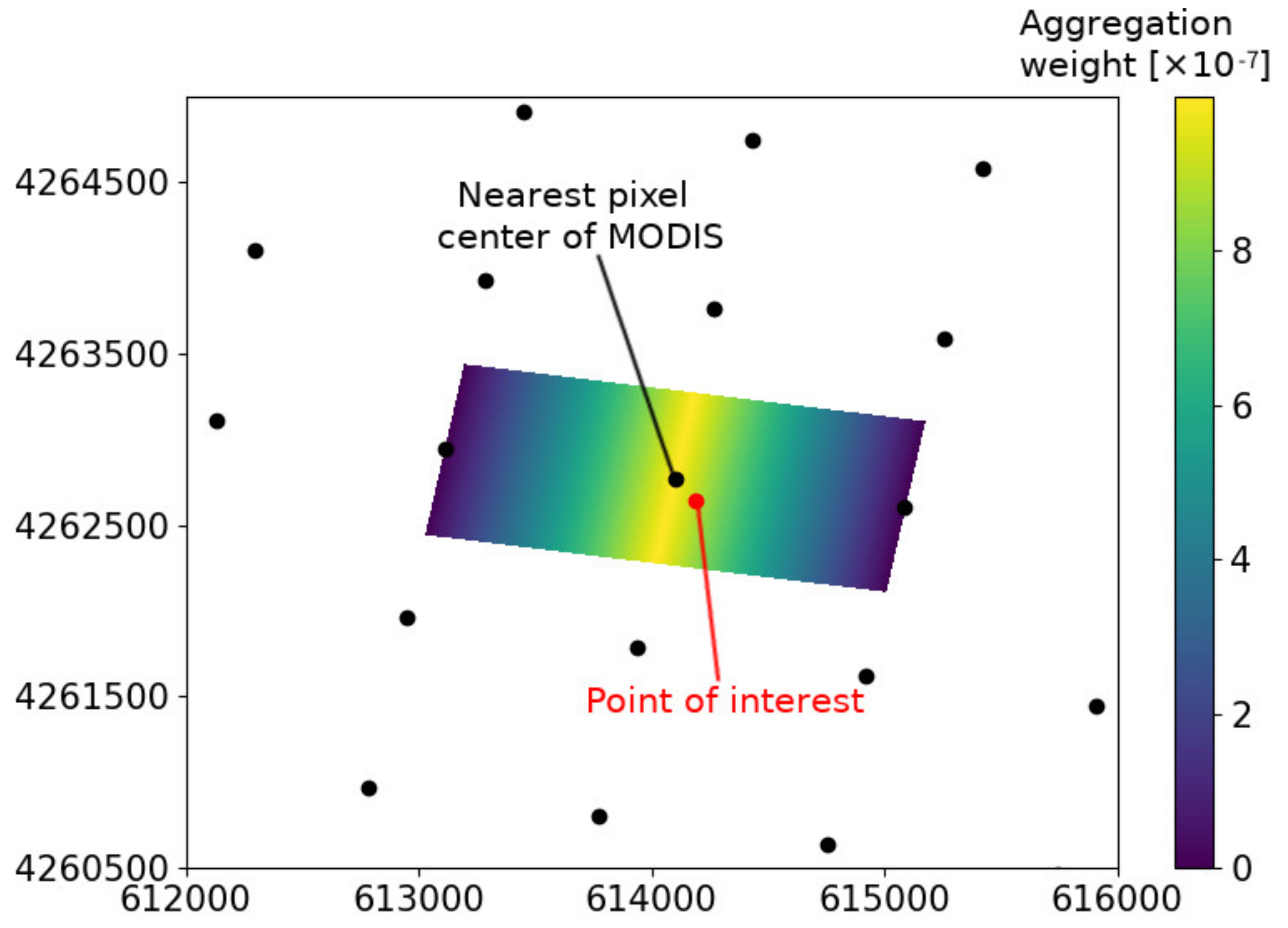
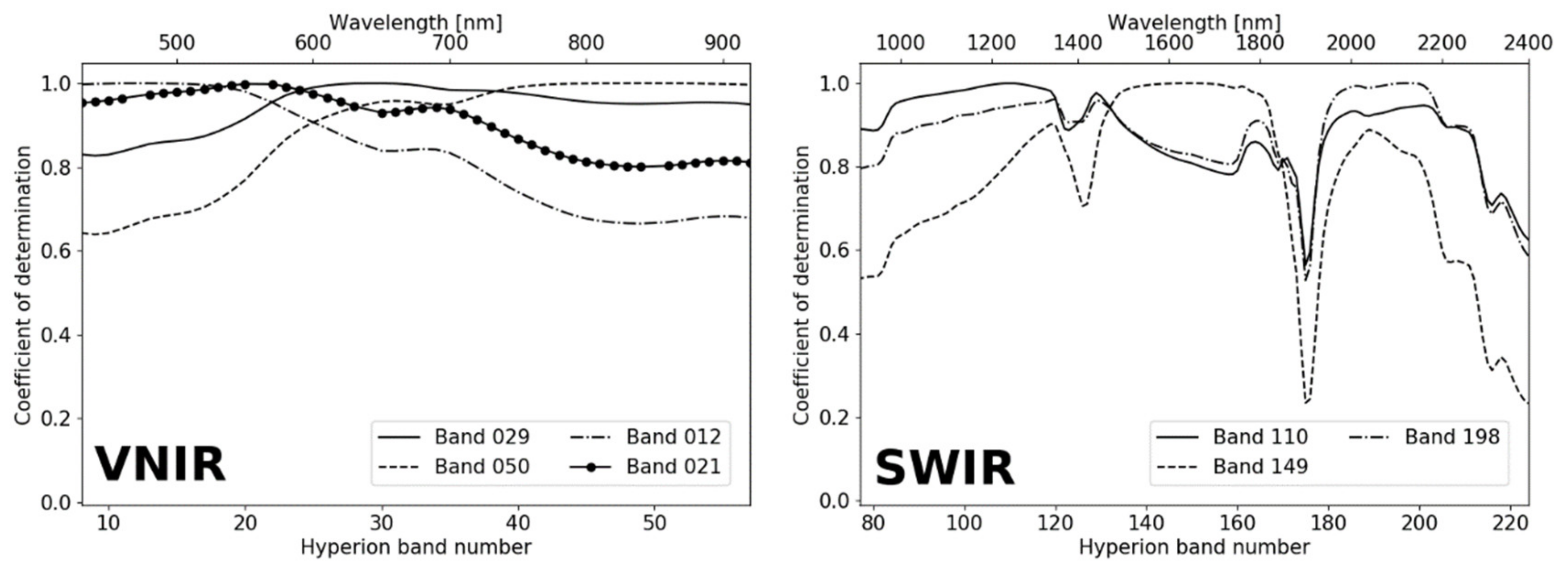
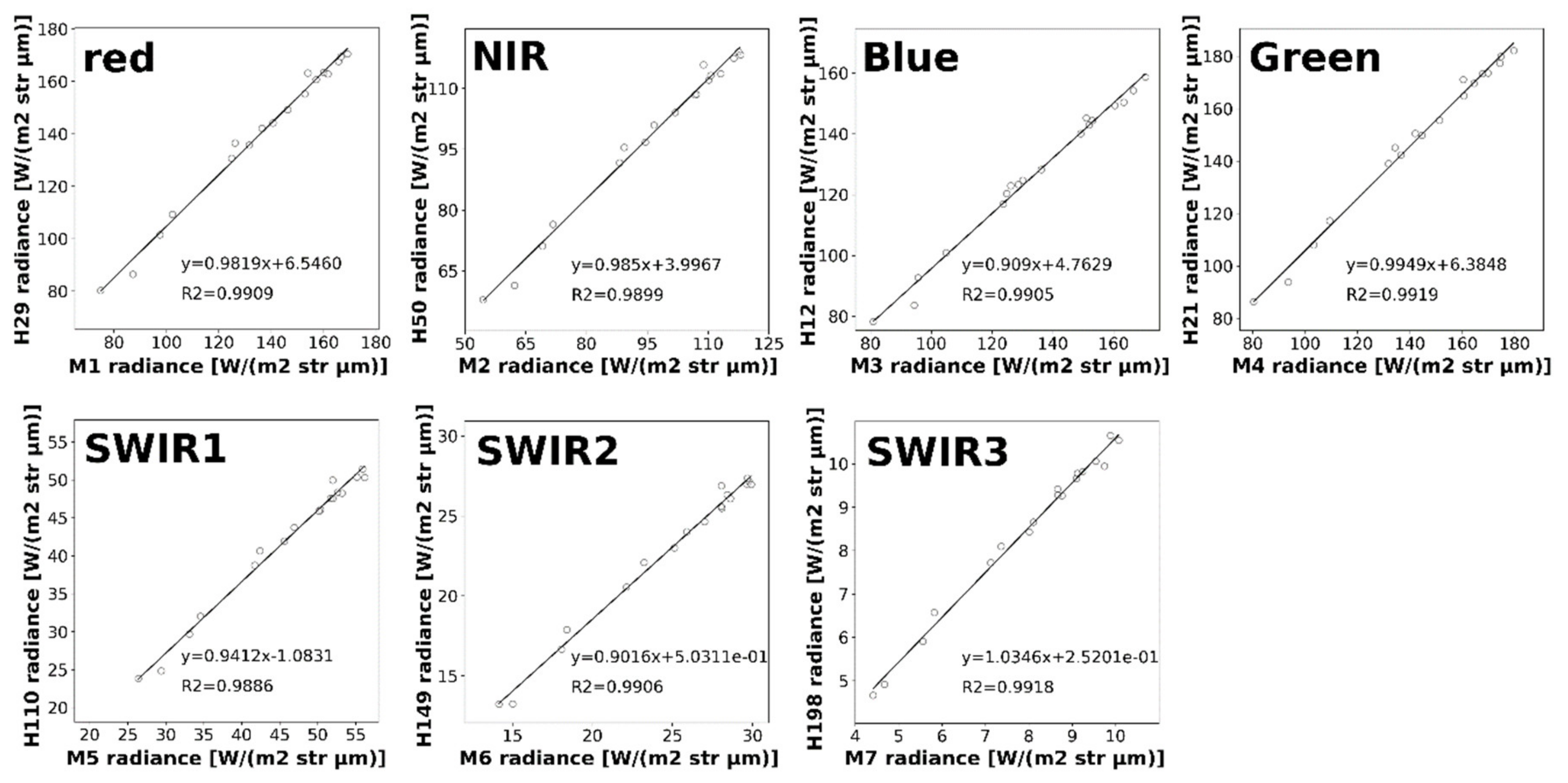
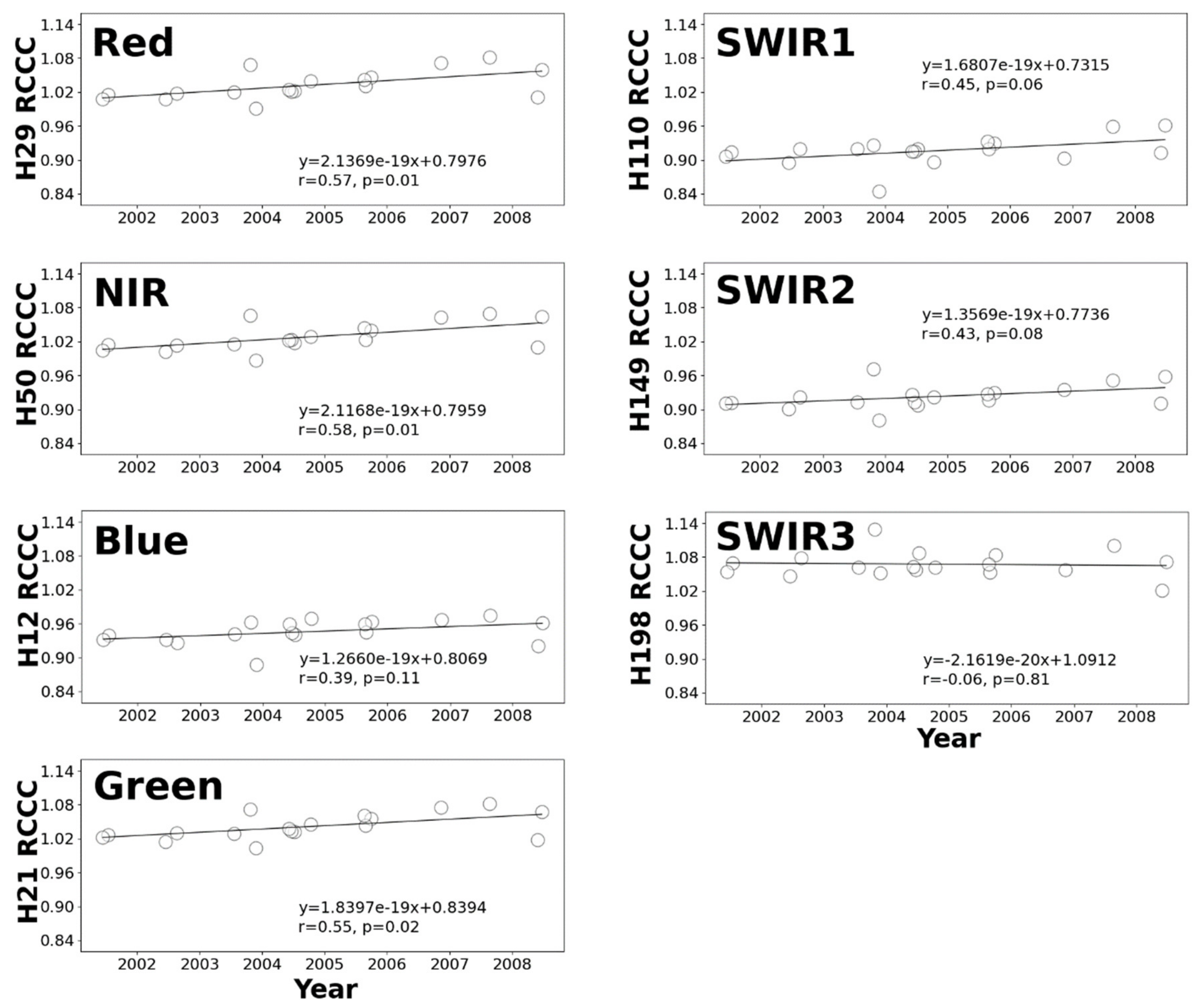
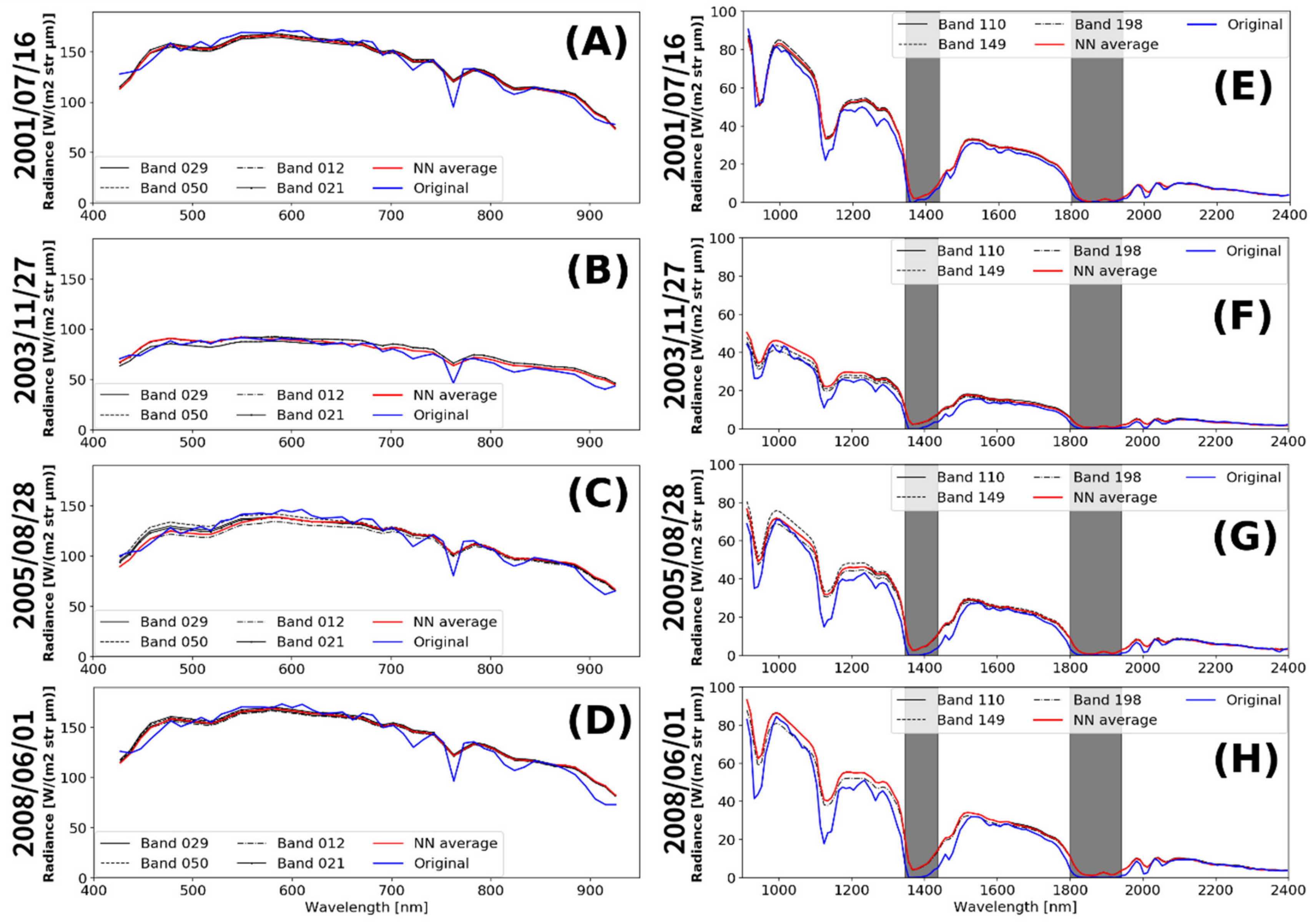

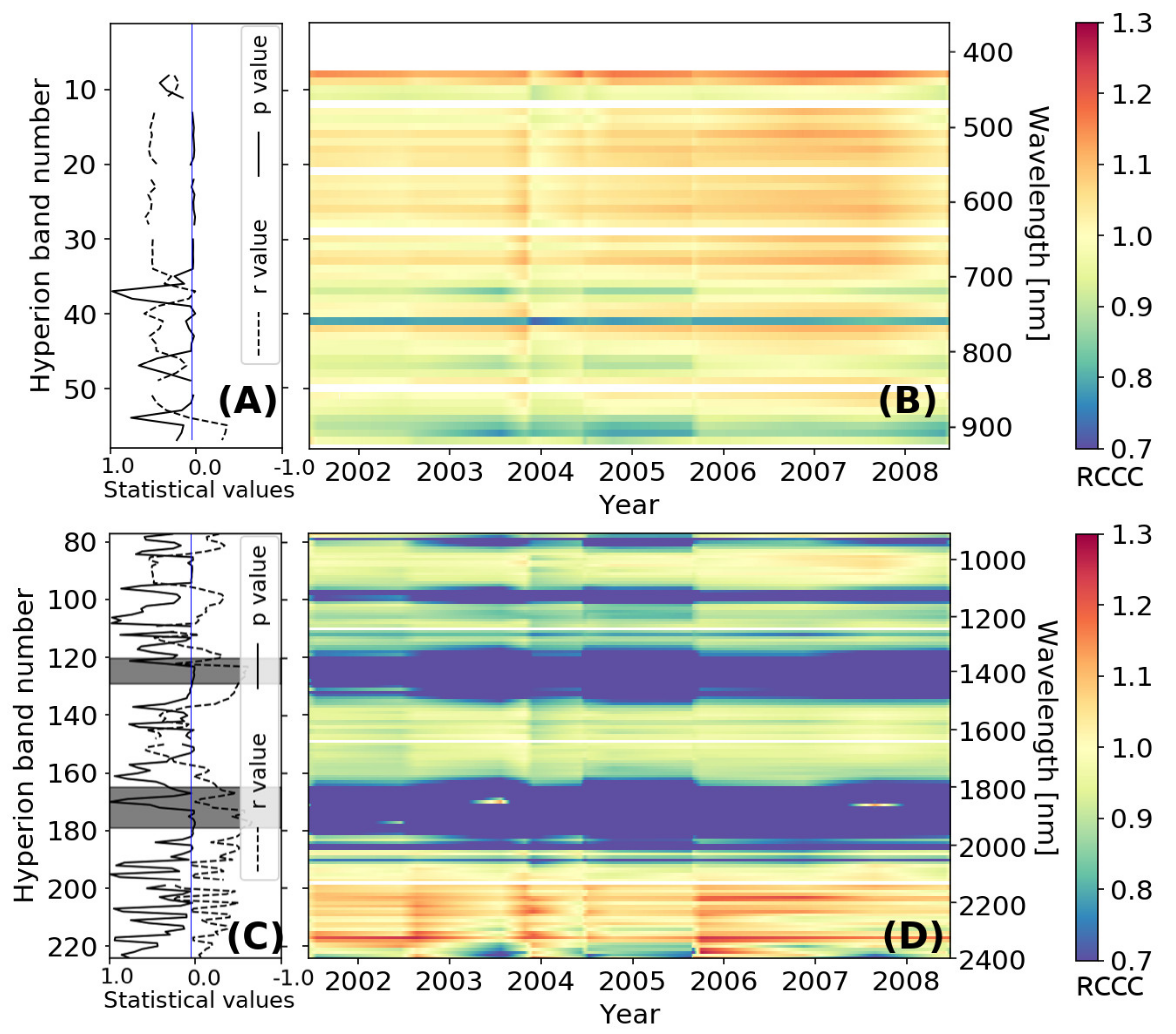
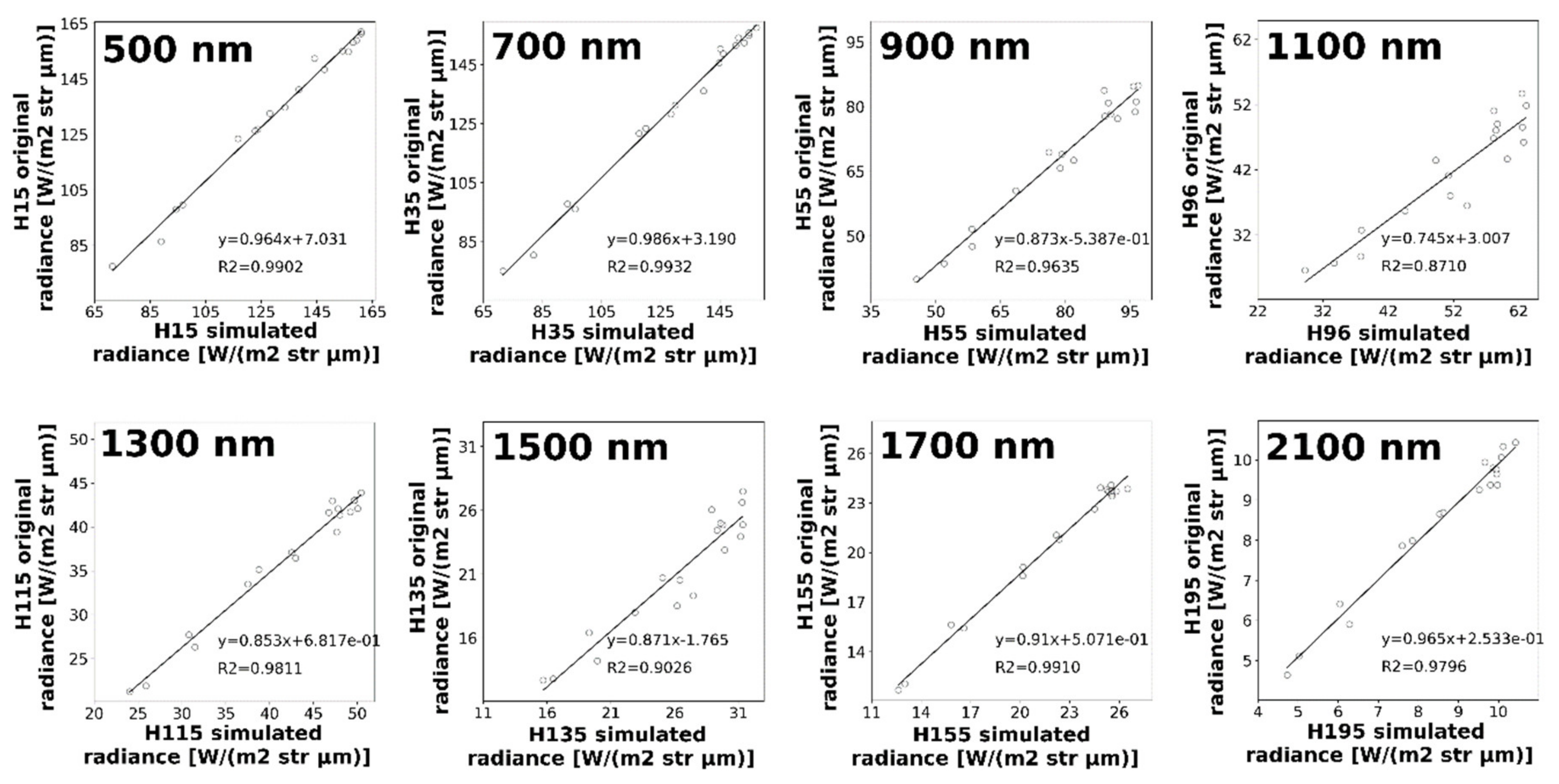
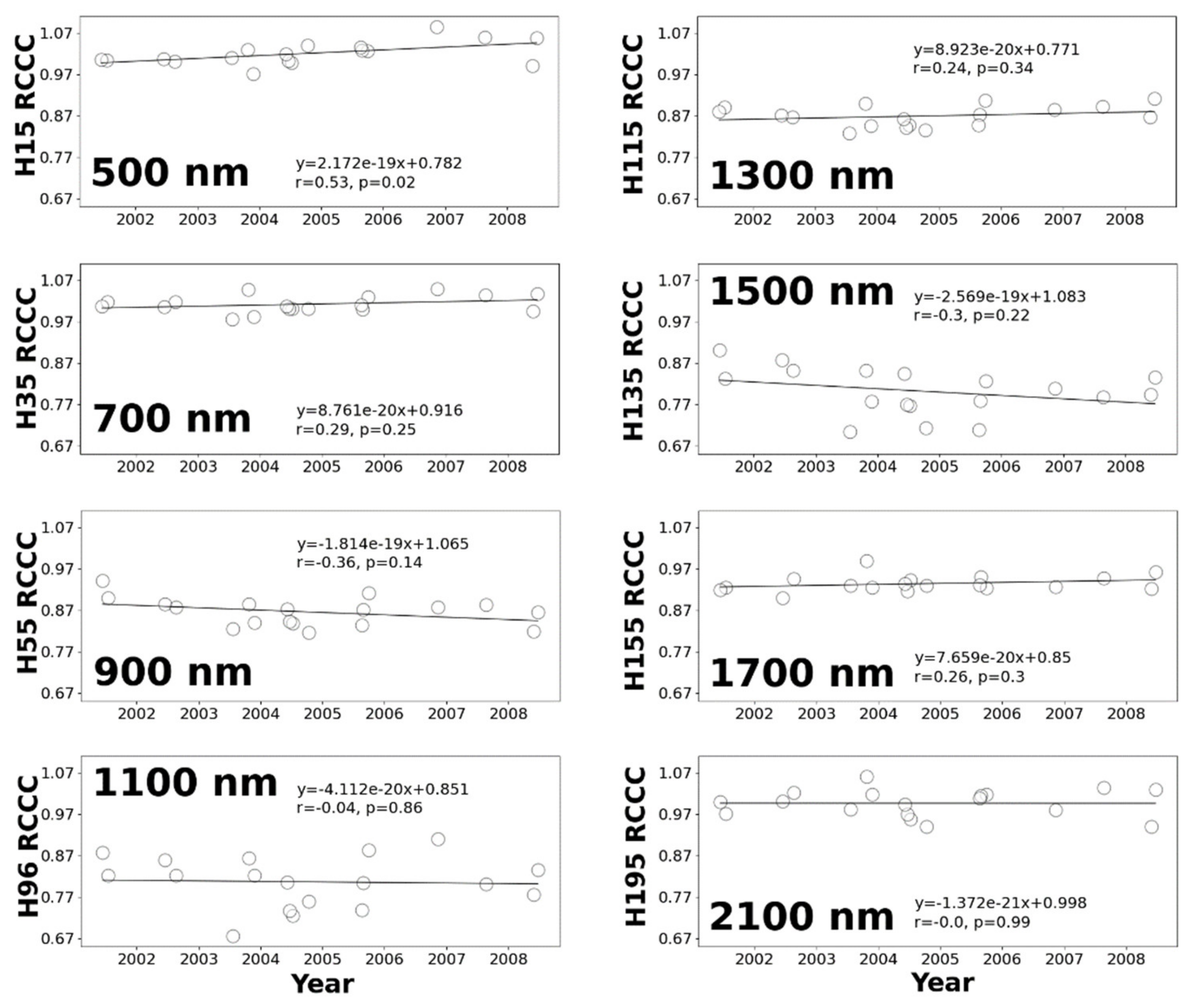
| Symbol | Interpretation |
|---|---|
| REFan | Analogous band data of reference sensor |
| CALan | Analogous band data of sensor to be calibrated |
| CALan,sim | CALan simulated from corresponding REFan by spectral adjustment |
| CALan,cor | CALan corrected (i.e., calibrated) by RCCC |
| CALother | Other band data except for analogous bands of sensor to be calibrated |
| CALother,sim | CALother simulated from reference bands (CALan) by spectral adjustment |
| CALother, cor | CALother corrected (i.e., calibrated) by RCCC |
| *1Band (Wavelength [nm]) | *2Band (Wavelength [nm]) | *3Band (Wavelength [nm]) | *4Band (wavelength [nm]) | *5Band (Wavelength [nm]) | *6Band (Wavelength [nm]) |
|---|---|---|---|---|---|
| 008 (426.82) | 041 (762.60) | 093 (1073.89) | 126 (1406.84) | 159 (1739.70) | 192 (2072.65) |
| 009 (436.99) | 042 (772.78) | 094 (1083.99) | 127 (1416.94) | 160 (1749.79) | 193 (2082.75) |
| 010 (447.17) | 043 (782.95) | 095 (1094.09) | 128 (1426.94) | 161 (1759.89) | 194 (2092.84) |
| 011 (457.34) | 044 (793.13) | 096 (1104.19) | 129 (1437.04) | 162 (1769.99) | 195 (2102.94) |
| 012 (467.52) | 045 (803.30) | 097 (1114.19) | 130 (1447.14) | 163 (1780.09) | 196 (2113.04) |
| 013 (477.69) | 046 (813.48) | 098 (1124.28) | 131 (1457.23) | 164 (1790.19) | 197 (2123.14) |
| 014 (487.87) | 047 (823.65) | 099 (1134.38) | 132 (1467.33) | 165 (1800.29) | 198 (2133.24) |
| 015 (498.04) | 048 (833.83) | 100 (1144.48) | 133 (1477.43) | 166 (1810.38) | 199 (2143.34) |
| 016 (508.22) | 049 (844.00) | 101 (1154.58) | 134 (1487.53) | 167 (1820.48) | 200 (2153.34) |
| 017 (518.39) | 050 (854.18) | 102 (1164.68) | 135 (1497.63) | 168 (1830.58) | 201 (2163.43) |
| 018 (528.57) | 051 (864.35) | 103 (1174.77) | 136 (1507.73) | 169 (1840.58) | 202 (2173.53) |
| 019 (538.74) | 052 (874.53) | 104 (1184.87) | 137 (1517.83) | 170 (1850.68) | 203 (2183.63) |
| 020 (548.92) | 053 (884.70) | 105 (1194.97) | 138 (1527.92) | 171 (1860.78) | 204 (2193.73) |
| 021 (559.09) | 054 (894.88) | 106 (1205.07) | 139 (1537.92) | 172 (1870.87) | 205 (2203.83) |
| 022 (569.27) | 055 (905.05) | 107 (1215.17) | 140 (1548.02) | 173 (1880.98) | 206 (2213.93) |
| 023 (579.45) | 056 (915.23) | 108 (1225.17) | 141 (1558.12) | 174 (1891.07) | 207 (2224.03) |
| 024 (589.62) | 057 (925.41) | 109 (1235.27) | 142 (1568.22) | 175 (1901.17) | 208 (2234.12) |
| 025 (599.80) | 077 (912.45) | 110 (1245.36) | 143 (1578.32) | 176 (1911.27) | 209 (2244.22) |
| 026 (609.97) | 078 (922.54) | 111 (1255.46) | 144 (1588.42) | 177 (1921.37) | 210 (2254.22) |
| 027 (620.15) | 079 (932.64) | 112 (1265.56) | 145 (1598.51) | 178 (1931.47) | 211 (2264.32) |
| 028 (630.32) | 080 (942.73) | 113 (1275.66) | 146 (1608.61) | 179 (1941.57) | 212 (2274.42) |
| 029 (640.50) | 081 (952.82) | 114 (1285.76) | 147 (1618.71) | 180 (1951.57) | 213 (2284.52) |
| 030 (650.67) | 082 (962.91) | 115 (1295.86) | 148 (1628.81) | 181 (1961.66) | 214 (2294.61) |
| 031 (660.85) | 083 (972.99) | 116 (1305.96) | 149 (1638.81) | 182 (1971.76) | 215 (2304.71) |
| 032 (671.02) | 084 (983.08) | 117 (1316.05) | 150 (1648.90) | 183 (1981.86) | 216 (2314.81) |
| 033 (681.20) | 085 (993.17) | 118 (1326.05) | 151 (1659.00) | 184 (1991.96) | 217 (2324.91) |
| 034 (691.37) | 086 (1003.30) | 119 (1336.15) | 152 (1669.10) | 185 (2002.06) | 218 (2335.01) |
| 035 (701.55) | 087 (1013.30) | 120 (1346.25) | 153 (1679.20) | 186 (2012.15) | 219 (2345.11) |
| 036 (711.72) | 088 (1023.40) | 121 (1356.35) | 154 (1689.30) | 187 (2022.25) | 220 (2355.21) |
| 037 (721.90) | 089 (1033.49) | 122 (1366.45) | 155 (1699.40) | 188 (2032.35) | 221 (2365.20) |
| 038 (732.07) | 090 (1043.59) | 123 (1376.55) | 156 (1709.50) | 189 (2042.45) | 222 (2375.30) |
| 039 (742.25) | 091 (1053.69) | 124 (1386.65) | 157 (1719.60) | 190 (2052.45) | 223 (2385.40) |
| 040 (752.43) | 092 (1063.79) | 125 (1396.74) | 158 (1729.70) | 191 (2062.55) | 224 (2395.50) |
| Band Description | MODIS Band Number and Wavelength | Hyperion Band Number and Wavelength |
|---|---|---|
| Red | Band 1 (645 ± 25 nm) | Band 29 (640.50 ± 10.32 nm) |
| NIR | Band 2 (858.5 ± 17.1 nm) | Band 50 (854.18 ± 11.28 nm) |
| Blue | Band 3 (469 ± 10 nm) | Band 12 (467.52 ± 11.39 nm) |
| Green | Band 4 (555 ± 10 nm) | Band 21 (559.09 ± 10.93 nm) |
| SWIR1 | Band 5 (1240 ± 10 nm) | Band 110 (1245.36 ± 10.74 nm) |
| SWIR2 | Band 6 (1640 ± 12 nm) | Band 149 (1638.81 ± 11.50 nm) |
| SWIR3 | Band 7 (2130 ± 25 nm) | Band 198 (2133.24 ± 10.73 nm) |
| Band Description | Red | NIR | Blue | Green | SWIR1 | SWIR2 | SWIR3 |
|---|---|---|---|---|---|---|---|
| MODIS/Hyperion band numbers | 1/29 | 2/50 | 3/12 | 4/21 | 5/110 | 6/149 | 7/198 |
| [%] | 3.21 | 2.82 | −5.42 | 4.13 | −8.41 | −7.75 | 6.75 |
| RMSEk [%] | 4.03 | 3.69 | 5.82 | 4.68 | 8.75 | 8.02 | 7.11 |
| Average of RCCC | 1.032 ± 0.025 | 1.028 ± 0.024 | 0.946 ± 0.022 | 1.041 ± 0.023 | 0.916 ± 0.025 | 0.923 ± 0.021 | 1.067 ± 0.023 |
| Spectral Regions | Variation in Original Hyperion | Variation after Our Calibration |
|---|---|---|
| 620–670 nm | 2.28 | 0.27 |
| 841–876 nm | 0.44 | 0.36 |
| 459–479 nm | 4.16 | 1.54 |
| 545–565 nm | 1.14 | 0.85 |
| 1230–1250 nm | 0.86 | 0.31 |
| 1628–1652 nm | 0.25 | 0.13 |
| 2105–2155 nm | 0.14 | 0.09 |
| Name of Error Source | Band 1 640 nm | Band 2 854 nm | Band 3 468 nm | Band 4 559 nm | Band 5 1245 nm | Band 6 1639 nm | Band 7 2133 nm |
|---|---|---|---|---|---|---|---|
| MODIS reflectance | 1.81 | 1.78 | 1.76 | 1.68 | 2.57 | 2.08 | 2.43 |
| Variability in atmospheric conditions | 0.14 | 0.10 | 0.30 | 0.17 | 0.06 | 0.04 | 0.22 |
| Soil line influence | 0.07 | 0.01 | 0.01 | 0.16 | 0.02 | 0.03 | 0.08 |
| Geolocation error | 0.20 | 0.19 | 0.24 | 0.21 | 0.20 | 0.18 | 0.25 |
| Solar irradiance | 1.73 | 2.68 | 2.65 | 1.94 | 1.88 | 1.52 | 1.27 |
| Root sum of squares | 2.52 | 3.22 | 3.20 | 2.59 | 3.19 | 2.58 | 2.76 |
| Name of Error Source | 500 nm | 700 nm | 900 nm | 1100 nm | 1300 nm | 1500 nm | 1700 nm | 2100 nm |
|---|---|---|---|---|---|---|---|---|
| Hyperion reference bands | 2.06 | 2.04 | 2.27 | 2.27 | 2.05 | 2.05 | 1.89 | 1.89 |
| Variability in atmospheric conditions | 0.31 | 0.50 | 3.38 | 2.94 | 1.08 | 3.98 | 0.39 | 0.52 |
| Soil line influence | 0.50 | 0.77 | 0.95 | 0.39 | 0.68 | 0.47 | 0.92 | 0.91 |
| Solar irradiance | 2.13 | 1.96 | 2.42 | 2.03 | 1.82 | 1.60 | 1.48 | 1.24 |
| Root sum of squares | 3.02 | 2.97 | 4.83 | 4.25 | 3.02 | 4.78 | 2.60 | 2.49 |
© 2020 by the authors. Licensee MDPI, Basel, Switzerland. This article is an open access article distributed under the terms and conditions of the Creative Commons Attribution (CC BY) license (http://creativecommons.org/licenses/by/4.0/).
Share and Cite
Mizuochi, H.; Tsuchida, S.; Obata, K.; Yamamoto, H.; Yamamoto, S. Combination of Cross- and Inter-Band Radiometric Calibrations for a Hyperspectral Sensor Using Model-Based Spectral Band Adjustment. Remote Sens. 2020, 12, 2011. https://doi.org/10.3390/rs12122011
Mizuochi H, Tsuchida S, Obata K, Yamamoto H, Yamamoto S. Combination of Cross- and Inter-Band Radiometric Calibrations for a Hyperspectral Sensor Using Model-Based Spectral Band Adjustment. Remote Sensing. 2020; 12(12):2011. https://doi.org/10.3390/rs12122011
Chicago/Turabian StyleMizuochi, Hiroki, Satoshi Tsuchida, Kenta Obata, Hirokazu Yamamoto, and Satoru Yamamoto. 2020. "Combination of Cross- and Inter-Band Radiometric Calibrations for a Hyperspectral Sensor Using Model-Based Spectral Band Adjustment" Remote Sensing 12, no. 12: 2011. https://doi.org/10.3390/rs12122011
APA StyleMizuochi, H., Tsuchida, S., Obata, K., Yamamoto, H., & Yamamoto, S. (2020). Combination of Cross- and Inter-Band Radiometric Calibrations for a Hyperspectral Sensor Using Model-Based Spectral Band Adjustment. Remote Sensing, 12(12), 2011. https://doi.org/10.3390/rs12122011




